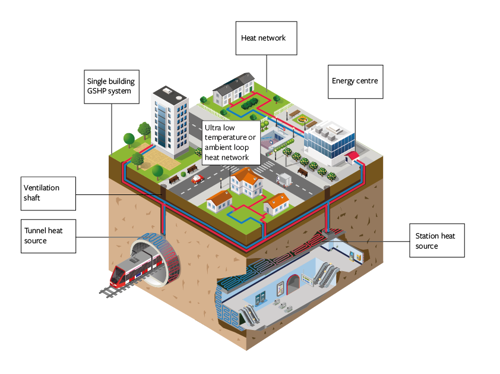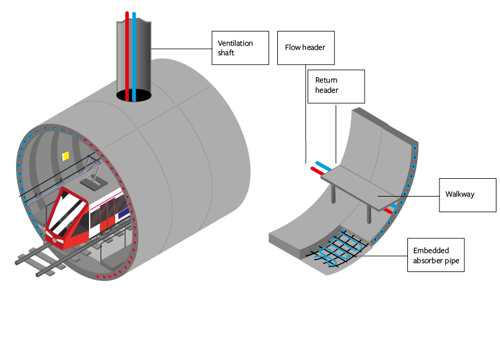
Project Spotlight: Investigating the potential for tunnels to provide a low carbon heating solution
Project Spotlight: Investigating the potential for tunnels to provide a low carbon heating solution
Share this
The University of Leeds and HS2 Ltd collaborated to investigate the potential for tunnels that were, at the time, expected to be constructed as part of Phase 2b of HS2, to supply heating and cooling in addition to their primary function.
The project required mapping future infrastructure assets which could be used to access geothermal energy in the Manchester and Crewe areas, a desktop assessment of likely thermal energy available, an estimate of installation costs of a tunnel energy system, engagement with potential heat users along the route and other stakeholders to understand barriers to deployment, and a financial analysis to demonstrate economic viability.
Decarbonising heating and cooling will be subject to competing demands for low-carbon and environmental energy sources. Power to-heat technologies such as heat pumps will place demands on the electricity grid that will also need to supply sufficient green electricity to enable the shift to electrified transport. Meanwhile, civil engineers are ever more aware of the need to reduce environmental impacts from infrastructure and seize opportunities to support decarbonisation. Dual use of buried infrastructure by thermal activation, so called “energy geostructures”, is an attractive route to contribute to both these aims. However, attempts to incorporate heat transfer pipes for thermal activation of tunnel linings in the UK has previously not been successful due to a combination of economics and insufficient programme time to permit necessary stakeholder engagement, making it impossible to accommodate the design and construction changes required. HS2 Phase 2b represented a significant opportunity for early engagement to encourage adoption of an energy tunnel solution. With development of heat network zoning policy in the UK, there was also a chance to develop a novel case study of energy geostructures used with district heating networks.


The University of Leeds’ engineering team’s assessment showed the geothermal activation of the tunnel linings had the potential to provide up to 13GWhr/year at each tunnel ventilation shaft where the heat could be accessed. This could heat the equivalent of 1200 homes. Engagement with external stakeholders including local authorities, heat network operators and large potential consumers found genuine enthusiasm for the use of tunnel heat. Costs and benefits for thermal activation of the tunnels to provide heating and cooling for rail station buildings were compared with those for air source heat pumps demonstrating positive financial returns, subject to economic uncertainties such as interest rates, inflation and energy prices. However, capital funding being derived from the Department for Transport with benefits potentially accruing to other national and local government policy areas was highlighted as a significant barrier.
The positive financial analysis, support from internal and external stakeholders, and potential for reputational benefits to HS2 supported the case for further development. Unfortunately, before this could occur this part of the HS2 project was discontinued. Nonetheless, the approach has been shown to be viable and is applicable to other projects. Further work would be required to refine costs, progress aspects of the design, and further engage stakeholders. Key policy developments in terms of energy policy and capital project financing would also accelerate progress.
Zoë Edmonds, Senior Innovation Manager at HS2 said, “The team from the University of Leeds demonstrated the potential feasibility and desirability of using some of HS2’s proposed transport tunnels to simultaneously harness heat energy, generating a significant additional benefit for the neighbouring community, and highlighting the potential for a new contribution to the future energy security and net zero targets of the UK. Incorporating learning from HS2 Phase One, Crossrail and other international tunnelling schemes like Turin metro, Professor Loveridge and team worked with HS2 to investigate this potential early in the projects’ development, before detailed designs were fixed, which was essential for the affordability and viability of the concept. I hope that by sharing these findings it encourages others to use a multidisciplinary lens early in project development to seek to maximise the value from major infrastructure investment.”
